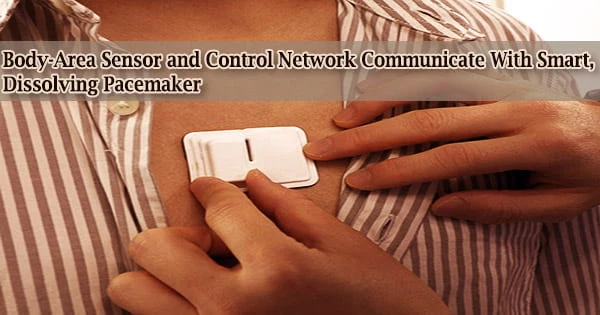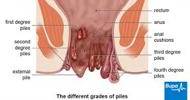Northwestern University researchers unveiled the world’s first transitory pacemaker last summer, a completely implanted, wireless device that dissolves harmlessly in the body once it’s no longer needed. They’ve now unveiled a smarter version that’s connected to a network of four soft, flexible, wireless wearable sensors and control units that are put around the upper torso.
The study will be published Friday (May 27) in the journal Science. The work was led by Northwestern’s John A. Rogers, Igor R. Efimov, and Dr. Rishi Arora.
The sensors communicate with one another to keep track of the body’s numerous physiological activities, such as body temperature, oxygen levels, respiration, muscle tone, physical activity, and the electrical activity of the heart.
The device then use algorithms to assess this combined activity in order to detect aberrant cardiac rhythms on its own and determine when and at what rate to pace the heart. All of this data is sent to a smartphone or tablet, allowing doctors to keep an eye on their patients from afar.
Patients who require temporary pacing after heart surgery or who are awaiting a permanent pacemaker can benefit from the novel transient pacemaker and sensor/control network. The pacemaker collects energy wirelessly from a network node, which is a small wireless device that is softly attached to the patient’s chest.
External hardware, like as wires, is no longer required with this technology (or leads). The researchers included a small, wearable haptic-feedback device that may be worn anywhere on the body to allow the system to connect with the patient.
When the sensors identify a problem (such as low battery power, incorrect device placement, or pacemaker dysfunction), the haptic device vibrates in a predefined manner to notify and inform wearers.
Insights from the experts
“This marks the first time we have paired soft, wearable electronics with transient electronic platforms,” Rogers said. “This approach could change the way patients receive care providing multinodal, closed-loop control over essential physiological processes through a wireless network of sensors and stimulators that operates in a manner inspired by the complex, biological feedback loops that control behaviors in living organisms.”
In current settings, temporary pacemakers require a wire that is connected to an external generator that stimulates the heart. When the heart regains its ability to stimulate itself appropriately, the wire has to be pulled out. As you might imagine, this is a pretty dramatic procedure to pull out a wire connected to the heart. We decided to approach this problem from a different angle. We created a pacemaker that simply dissolves and does not need to be removed. This avoids the dangerous step of pulling out the wire.
Igor R. Efimov
The technology frees patients from monitoring and stimulation devices that keep them restricted to a hospital setting for temporary cardiac pacing. Patients could instead recover in the privacy of their own homes while benefiting from the peace of mind that comes with being watched remotely by their doctors. This would also save health-care costs and free up hospital beds for other patients.
“In current settings, temporary pacemakers require a wire that is connected to an external generator that stimulates the heart,” Efimov said. “When the heart regains its ability to stimulate itself appropriately, the wire has to be pulled out. As you might imagine, this is a pretty dramatic procedure to pull out a wire connected to the heart. We decided to approach this problem from a different angle. We created a pacemaker that simply dissolves and does not need to be removed. This avoids the dangerous step of pulling out the wire.”
“Current pacemakers are quite intelligent and respond well to the changing needs of the patients,” Arora said. “But the wearable modules do everything traditional pacemakers do and more. A patient basically wears a little patch on their chest and gets real-time feedback to control the pacemaker. Not only is the pacemaker itself bioresorbable, it is controlled by a soft, wearable patch that allows the pacemaker to respond to the usual activities of life without needing implantable sensors.”
Rogers is the director of the Querrey Simpson Institute for Bioelectronics (QSIB) and the Louis Simpson and Kimberly Querrey Professor of Materials Science and Engineering, Biomedical Engineering, and Neurological Surgery at Northwestern University’s McCormick School of Engineering and Northwestern University Feinberg School of Medicine.
Efimov is a biomedical engineering professor at McCormick and a medicine (cardiology) professor at Feinberg. Arora is a co-director of the Center for Arrhythmia Research and a professor of medicine at Feinberg.
‘Body-area network’
Rogers and his group have been creating soft, flexible, wireless wearable gadgets and bioresorbable electrical technologies for for two decades, making him a bioelectronics pioneer. Rogers and colleagues coupled and coordinated their bioresorbable, leadless pacemaker with four distinct skin-interfaced devices to function together in the latest study.
The skin-mounted devices are soft and flexible, and they can be easily peeled off after use, avoiding the need for surgery. After a time of use, the pacemaker degrades naturally in the body.
The “body-area network” includes:
- A battery-free transient, bioresorbable pacemaker to temporarily pace the heart;
- A cardiac module that rests on the chest to give power to the implanted pacemaker and control stimulation parameters, as well as sense electrical activity and heart sounds;
- A hemodynamics module on the forehead that senses pulse oximetry, tissue oxygenation, and vascular tone;
- A respiratory module at the base of the throat that monitors coughing and respiratory activity; and
- A multi-haptic-feedback module that vibrates and pulses in a variety of patterns to communicate with the patient.
“We wanted to demonstrate that it’s possible to deploy multiple different types of devices, each performing essential functions in a wirelessly coordinated manner across the body,” Rogers said.
“Some are sensing. Some are delivering power. Some are stimulating. Some are providing control signals. But they all work together, trading information, making decisions based on algorithms and reacting to changing conditions. The vision of multiple bioelectronic devices all talking to one another and performing different functions at different relevant anatomical locations is a frontier area that we will continue to pursue going into the future.”
New advances, on-demand pacing
Northwestern researchers have made numerous advancements to the transient pacemaker technology since it was originally revealed a year ago. The new device is more flexible and stretchy than the old one, allowing it to better accommodate the changing characteristics of a beating heart.
A biocompatible adhesive created in Rogers’ and Efimov’s labs is also used in this iteration. The adhesive enables the lightweight, thin gadget to softly adhere to the surface of the heart without the use of sutures.
Another significant feature is that the transitory pacemaker now delivers an anti-inflammatory medication to reduce foreign-body reactions as it dissolves slowly and painlessly. The device’s ability to offer pacing on-demand, based on when the patient requires it, is perhaps the most significant advancement.
The chest-mounted cardiac module, which is synced with the pacemaker, records an electrocardiogram in real time to monitor heart function. Researchers in the study compared this wireless technology to gold-standard electrocardiograms and discovered that it was just as accurate and precise as clinical-grade equipment.
“The cardiac module literally tells the pacemaker to apply stimulus to the heart,” Efimov explained. “If normal activity is regained, then it stops pacing. This is important because if you stimulate the heart when it’s unnecessary, then you risk inducing arrhythmia.”
“The pacing system is completely autonomous,” said Yeon Sik Choi, a postdoctoral fellow in Rogers’ lab and co-first author of the paper. “It can automatically detect a problem and apply treatment. It’s easy and self-contained with minimal external needs.”
Health care gentle enough for newborns
Rogers, Efimov, Arora, and their colleagues feel that their system will benefit the most vulnerable patients the most. Approximately 40,000 newborns are born each year with a hole in the wall separating the upper chambers of their hearts.
Approximately 10,000 of these instances are life-threatening and require prompt surgical intervention. A temporary pacemaker is implanted in every baby after surgery.
“The good news is this is a temporary condition,” Efimov said. “After about five to seven days, the heart regains its ability to stimulate itself and no longer needs a pacemaker. The procedure to remove the pacemaker has improved greatly over the years, so the rate of complications is low. But we could free these babies from the wires connecting to an external generator and free them from needing a second procedure.”
The study was supported by the Leducq Foundation (project RHYTHM and award number R01-HL141470), the American Heart Association (award number 19PRE34380781), and the National Science Foundation (award number 1842165), and the National Institutes of Health (award number 5K99-HL148523-02). The paper’s co-first authors are Yeon Sik Choi, Hyoyoung Jeong, and Rose Yin.
















